Early Childhood Curriculum Design and Implementation Assignment
VerifiedAdded on 2021/11/19
|7
|1598
|72
Homework Assignment
AI Summary
This assignment delves into the multifaceted aspects of designing an early childhood curriculum. It begins with a definition of curriculum, advocating for a holistic approach that connects mind, spirit, and body, emphasizing the importance of the physical, personal, social, emotional, and cognitive development of young children. The assignment then explores the intent behind curriculum design, highlighting the significance of understanding children's cultural and social backgrounds, using a case study of a visual learner to illustrate the impact of individual learning preferences. Furthermore, it justifies the inclusion of specific celebrations, such as Anzac Day, into the curriculum, explaining its role in fostering children's understanding of their world and developing an emotional connection to their country. The assignment also advocates for the integration of indoor and outdoor learning environments, such as gardening, to promote responsibility, creativity, and physical development. Finally, it provides a structured planning example for an outdoor gardening activity, detailing materials, procedures, and the educational benefits of the activity.
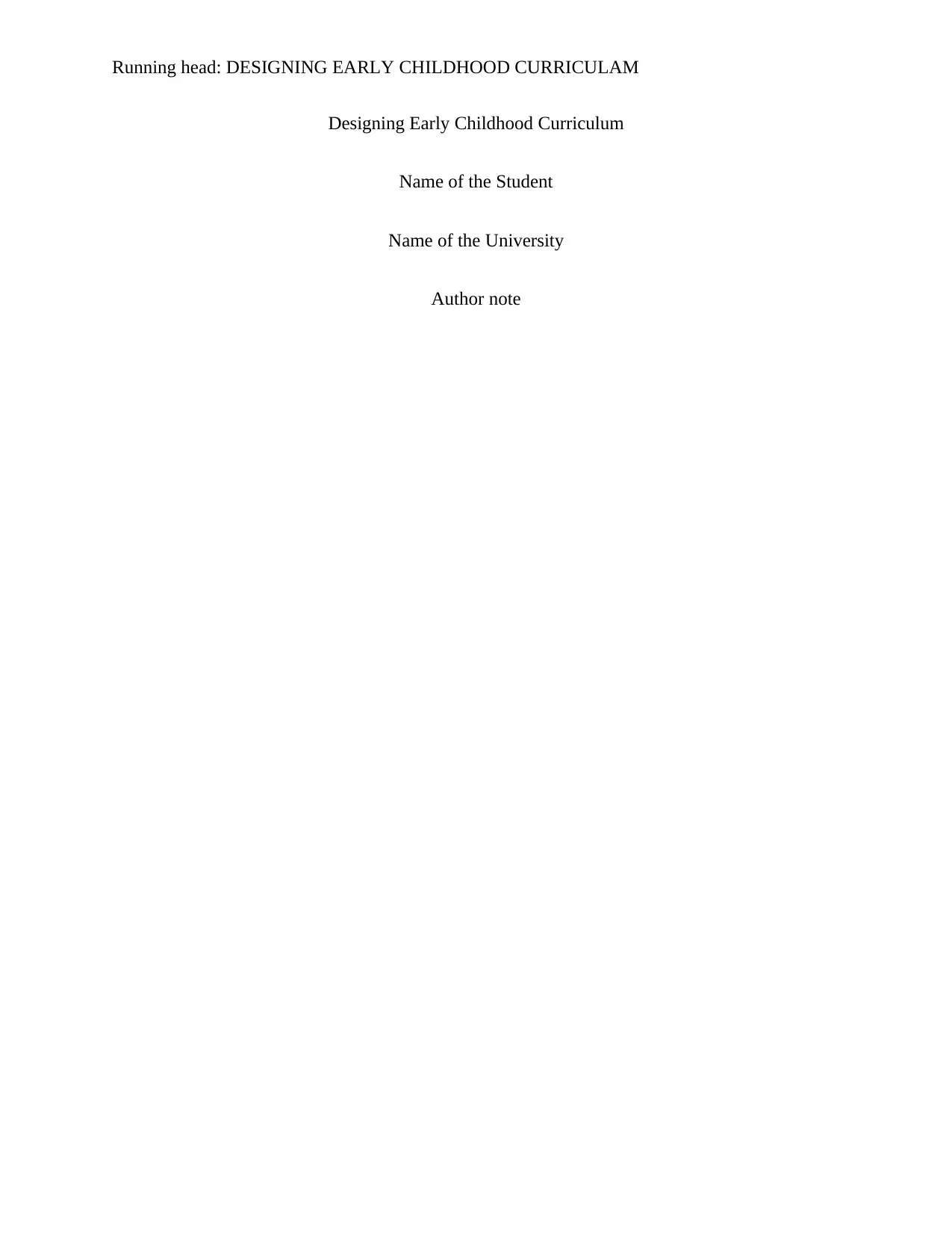
Running head: DESIGNING EARLY CHILDHOOD CURRICULAM
Designing Early Childhood Curriculum
Name of the Student
Name of the University
Author note
Designing Early Childhood Curriculum
Name of the Student
Name of the University
Author note
Paraphrase This Document
Need a fresh take? Get an instant paraphrase of this document with our AI Paraphraser
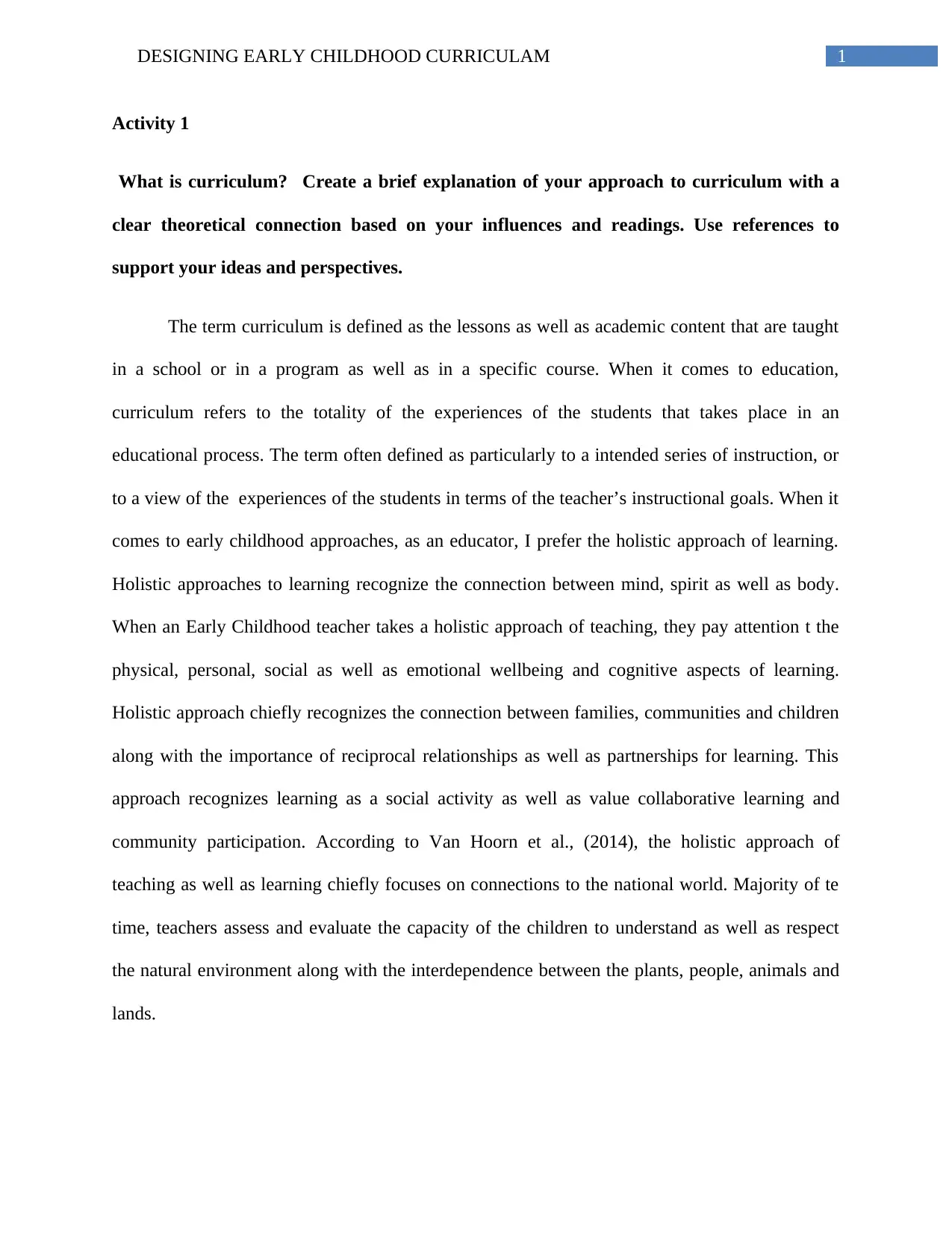
1DESIGNING EARLY CHILDHOOD CURRICULAM
Activity 1
What is curriculum? Create a brief explanation of your approach to curriculum with a
clear theoretical connection based on your influences and readings. Use references to
support your ideas and perspectives.
The term curriculum is defined as the lessons as well as academic content that are taught
in a school or in a program as well as in a specific course. When it comes to education,
curriculum refers to the totality of the experiences of the students that takes place in an
educational process. The term often defined as particularly to a intended series of instruction, or
to a view of the experiences of the students in terms of the teacher’s instructional goals. When it
comes to early childhood approaches, as an educator, I prefer the holistic approach of learning.
Holistic approaches to learning recognize the connection between mind, spirit as well as body.
When an Early Childhood teacher takes a holistic approach of teaching, they pay attention t the
physical, personal, social as well as emotional wellbeing and cognitive aspects of learning.
Holistic approach chiefly recognizes the connection between families, communities and children
along with the importance of reciprocal relationships as well as partnerships for learning. This
approach recognizes learning as a social activity as well as value collaborative learning and
community participation. According to Van Hoorn et al., (2014), the holistic approach of
teaching as well as learning chiefly focuses on connections to the national world. Majority of te
time, teachers assess and evaluate the capacity of the children to understand as well as respect
the natural environment along with the interdependence between the plants, people, animals and
lands.
Activity 1
What is curriculum? Create a brief explanation of your approach to curriculum with a
clear theoretical connection based on your influences and readings. Use references to
support your ideas and perspectives.
The term curriculum is defined as the lessons as well as academic content that are taught
in a school or in a program as well as in a specific course. When it comes to education,
curriculum refers to the totality of the experiences of the students that takes place in an
educational process. The term often defined as particularly to a intended series of instruction, or
to a view of the experiences of the students in terms of the teacher’s instructional goals. When it
comes to early childhood approaches, as an educator, I prefer the holistic approach of learning.
Holistic approaches to learning recognize the connection between mind, spirit as well as body.
When an Early Childhood teacher takes a holistic approach of teaching, they pay attention t the
physical, personal, social as well as emotional wellbeing and cognitive aspects of learning.
Holistic approach chiefly recognizes the connection between families, communities and children
along with the importance of reciprocal relationships as well as partnerships for learning. This
approach recognizes learning as a social activity as well as value collaborative learning and
community participation. According to Van Hoorn et al., (2014), the holistic approach of
teaching as well as learning chiefly focuses on connections to the national world. Majority of te
time, teachers assess and evaluate the capacity of the children to understand as well as respect
the natural environment along with the interdependence between the plants, people, animals and
lands.
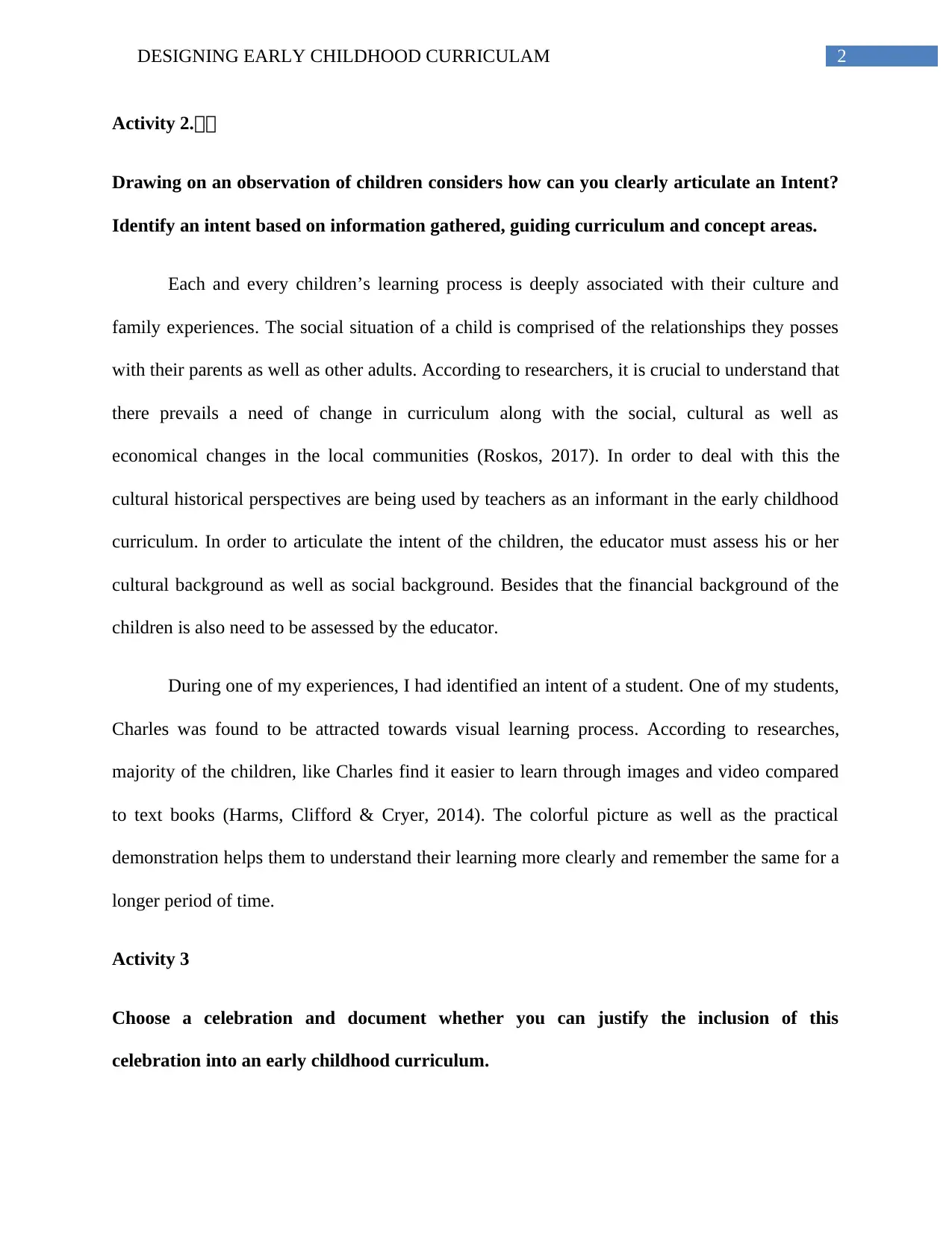
2DESIGNING EARLY CHILDHOOD CURRICULAM
Activity 2.ᅠᅠ
Drawing on an observation of children considers how can you clearly articulate an Intent?
Identify an intent based on information gathered, guiding curriculum and concept areas.
Each and every children’s learning process is deeply associated with their culture and
family experiences. The social situation of a child is comprised of the relationships they posses
with their parents as well as other adults. According to researchers, it is crucial to understand that
there prevails a need of change in curriculum along with the social, cultural as well as
economical changes in the local communities (Roskos, 2017). In order to deal with this the
cultural historical perspectives are being used by teachers as an informant in the early childhood
curriculum. In order to articulate the intent of the children, the educator must assess his or her
cultural background as well as social background. Besides that the financial background of the
children is also need to be assessed by the educator.
During one of my experiences, I had identified an intent of a student. One of my students,
Charles was found to be attracted towards visual learning process. According to researches,
majority of the children, like Charles find it easier to learn through images and video compared
to text books (Harms, Clifford & Cryer, 2014). The colorful picture as well as the practical
demonstration helps them to understand their learning more clearly and remember the same for a
longer period of time.
Activity 3
Choose a celebration and document whether you can justify the inclusion of this
celebration into an early childhood curriculum.
Activity 2.ᅠᅠ
Drawing on an observation of children considers how can you clearly articulate an Intent?
Identify an intent based on information gathered, guiding curriculum and concept areas.
Each and every children’s learning process is deeply associated with their culture and
family experiences. The social situation of a child is comprised of the relationships they posses
with their parents as well as other adults. According to researchers, it is crucial to understand that
there prevails a need of change in curriculum along with the social, cultural as well as
economical changes in the local communities (Roskos, 2017). In order to deal with this the
cultural historical perspectives are being used by teachers as an informant in the early childhood
curriculum. In order to articulate the intent of the children, the educator must assess his or her
cultural background as well as social background. Besides that the financial background of the
children is also need to be assessed by the educator.
During one of my experiences, I had identified an intent of a student. One of my students,
Charles was found to be attracted towards visual learning process. According to researches,
majority of the children, like Charles find it easier to learn through images and video compared
to text books (Harms, Clifford & Cryer, 2014). The colorful picture as well as the practical
demonstration helps them to understand their learning more clearly and remember the same for a
longer period of time.
Activity 3
Choose a celebration and document whether you can justify the inclusion of this
celebration into an early childhood curriculum.
⊘ This is a preview!⊘
Do you want full access?
Subscribe today to unlock all pages.

Trusted by 1+ million students worldwide
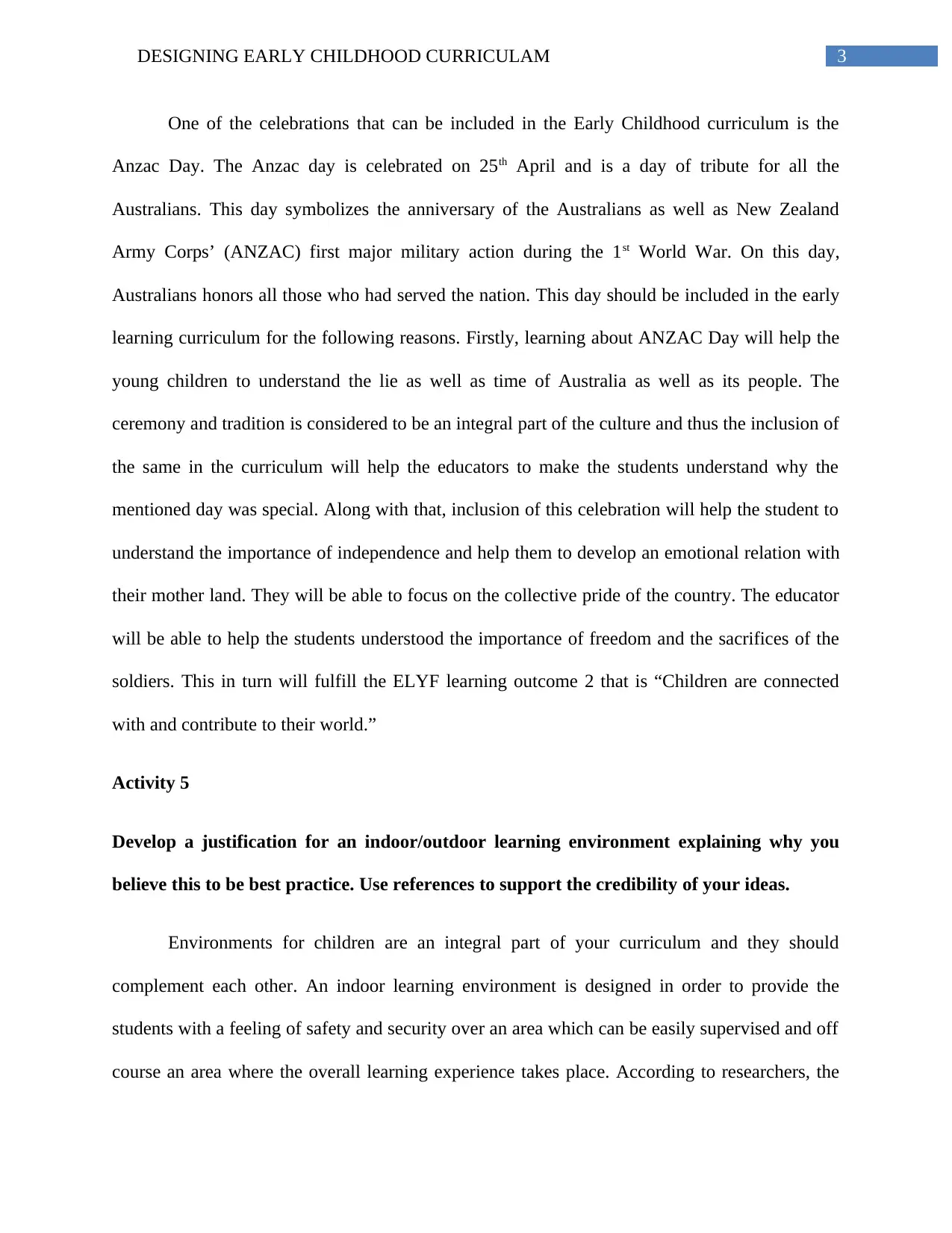
3DESIGNING EARLY CHILDHOOD CURRICULAM
One of the celebrations that can be included in the Early Childhood curriculum is the
Anzac Day. The Anzac day is celebrated on 25th April and is a day of tribute for all the
Australians. This day symbolizes the anniversary of the Australians as well as New Zealand
Army Corps’ (ANZAC) first major military action during the 1st World War. On this day,
Australians honors all those who had served the nation. This day should be included in the early
learning curriculum for the following reasons. Firstly, learning about ANZAC Day will help the
young children to understand the lie as well as time of Australia as well as its people. The
ceremony and tradition is considered to be an integral part of the culture and thus the inclusion of
the same in the curriculum will help the educators to make the students understand why the
mentioned day was special. Along with that, inclusion of this celebration will help the student to
understand the importance of independence and help them to develop an emotional relation with
their mother land. They will be able to focus on the collective pride of the country. The educator
will be able to help the students understood the importance of freedom and the sacrifices of the
soldiers. This in turn will fulfill the ELYF learning outcome 2 that is “Children are connected
with and contribute to their world.”
Activity 5
Develop a justification for an indoor/outdoor learning environment explaining why you
believe this to be best practice. Use references to support the credibility of your ideas.
Environments for children are an integral part of your curriculum and they should
complement each other. An indoor learning environment is designed in order to provide the
students with a feeling of safety and security over an area which can be easily supervised and off
course an area where the overall learning experience takes place. According to researchers, the
One of the celebrations that can be included in the Early Childhood curriculum is the
Anzac Day. The Anzac day is celebrated on 25th April and is a day of tribute for all the
Australians. This day symbolizes the anniversary of the Australians as well as New Zealand
Army Corps’ (ANZAC) first major military action during the 1st World War. On this day,
Australians honors all those who had served the nation. This day should be included in the early
learning curriculum for the following reasons. Firstly, learning about ANZAC Day will help the
young children to understand the lie as well as time of Australia as well as its people. The
ceremony and tradition is considered to be an integral part of the culture and thus the inclusion of
the same in the curriculum will help the educators to make the students understand why the
mentioned day was special. Along with that, inclusion of this celebration will help the student to
understand the importance of independence and help them to develop an emotional relation with
their mother land. They will be able to focus on the collective pride of the country. The educator
will be able to help the students understood the importance of freedom and the sacrifices of the
soldiers. This in turn will fulfill the ELYF learning outcome 2 that is “Children are connected
with and contribute to their world.”
Activity 5
Develop a justification for an indoor/outdoor learning environment explaining why you
believe this to be best practice. Use references to support the credibility of your ideas.
Environments for children are an integral part of your curriculum and they should
complement each other. An indoor learning environment is designed in order to provide the
students with a feeling of safety and security over an area which can be easily supervised and off
course an area where the overall learning experience takes place. According to researchers, the
Paraphrase This Document
Need a fresh take? Get an instant paraphrase of this document with our AI Paraphraser
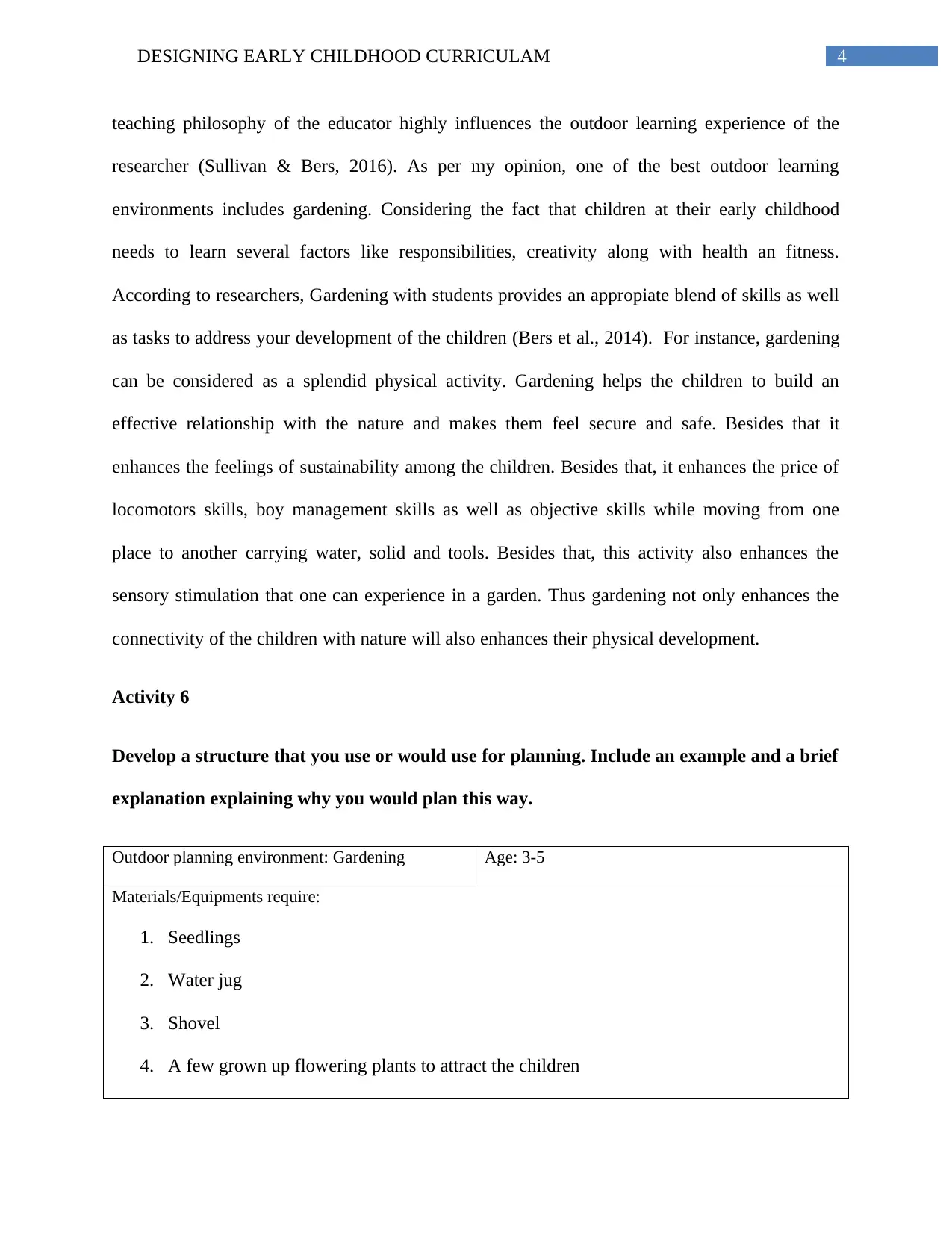
4DESIGNING EARLY CHILDHOOD CURRICULAM
teaching philosophy of the educator highly influences the outdoor learning experience of the
researcher (Sullivan & Bers, 2016). As per my opinion, one of the best outdoor learning
environments includes gardening. Considering the fact that children at their early childhood
needs to learn several factors like responsibilities, creativity along with health an fitness.
According to researchers, Gardening with students provides an appropiate blend of skills as well
as tasks to address your development of the children (Bers et al., 2014). For instance, gardening
can be considered as a splendid physical activity. Gardening helps the children to build an
effective relationship with the nature and makes them feel secure and safe. Besides that it
enhances the feelings of sustainability among the children. Besides that, it enhances the price of
locomotors skills, boy management skills as well as objective skills while moving from one
place to another carrying water, solid and tools. Besides that, this activity also enhances the
sensory stimulation that one can experience in a garden. Thus gardening not only enhances the
connectivity of the children with nature will also enhances their physical development.
Activity 6
Develop a structure that you use or would use for planning. Include an example and a brief
explanation explaining why you would plan this way.
Outdoor planning environment: Gardening Age: 3-5
Materials/Equipments require:
1. Seedlings
2. Water jug
3. Shovel
4. A few grown up flowering plants to attract the children
teaching philosophy of the educator highly influences the outdoor learning experience of the
researcher (Sullivan & Bers, 2016). As per my opinion, one of the best outdoor learning
environments includes gardening. Considering the fact that children at their early childhood
needs to learn several factors like responsibilities, creativity along with health an fitness.
According to researchers, Gardening with students provides an appropiate blend of skills as well
as tasks to address your development of the children (Bers et al., 2014). For instance, gardening
can be considered as a splendid physical activity. Gardening helps the children to build an
effective relationship with the nature and makes them feel secure and safe. Besides that it
enhances the feelings of sustainability among the children. Besides that, it enhances the price of
locomotors skills, boy management skills as well as objective skills while moving from one
place to another carrying water, solid and tools. Besides that, this activity also enhances the
sensory stimulation that one can experience in a garden. Thus gardening not only enhances the
connectivity of the children with nature will also enhances their physical development.
Activity 6
Develop a structure that you use or would use for planning. Include an example and a brief
explanation explaining why you would plan this way.
Outdoor planning environment: Gardening Age: 3-5
Materials/Equipments require:
1. Seedlings
2. Water jug
3. Shovel
4. A few grown up flowering plants to attract the children
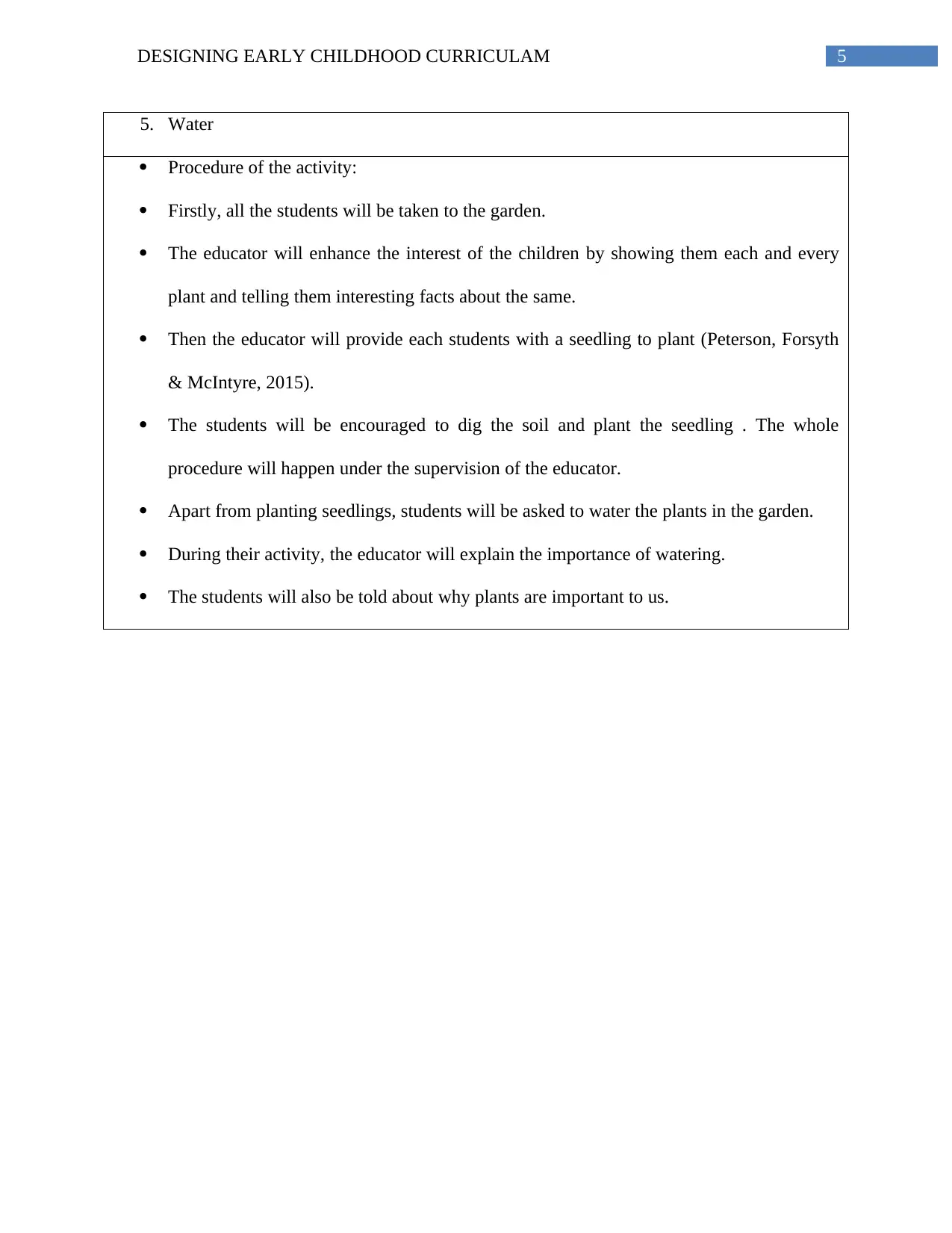
5DESIGNING EARLY CHILDHOOD CURRICULAM
5. Water
Procedure of the activity:
Firstly, all the students will be taken to the garden.
The educator will enhance the interest of the children by showing them each and every
plant and telling them interesting facts about the same.
Then the educator will provide each students with a seedling to plant (Peterson, Forsyth
& McIntyre, 2015).
The students will be encouraged to dig the soil and plant the seedling . The whole
procedure will happen under the supervision of the educator.
Apart from planting seedlings, students will be asked to water the plants in the garden.
During their activity, the educator will explain the importance of watering.
The students will also be told about why plants are important to us.
5. Water
Procedure of the activity:
Firstly, all the students will be taken to the garden.
The educator will enhance the interest of the children by showing them each and every
plant and telling them interesting facts about the same.
Then the educator will provide each students with a seedling to plant (Peterson, Forsyth
& McIntyre, 2015).
The students will be encouraged to dig the soil and plant the seedling . The whole
procedure will happen under the supervision of the educator.
Apart from planting seedlings, students will be asked to water the plants in the garden.
During their activity, the educator will explain the importance of watering.
The students will also be told about why plants are important to us.
⊘ This is a preview!⊘
Do you want full access?
Subscribe today to unlock all pages.

Trusted by 1+ million students worldwide
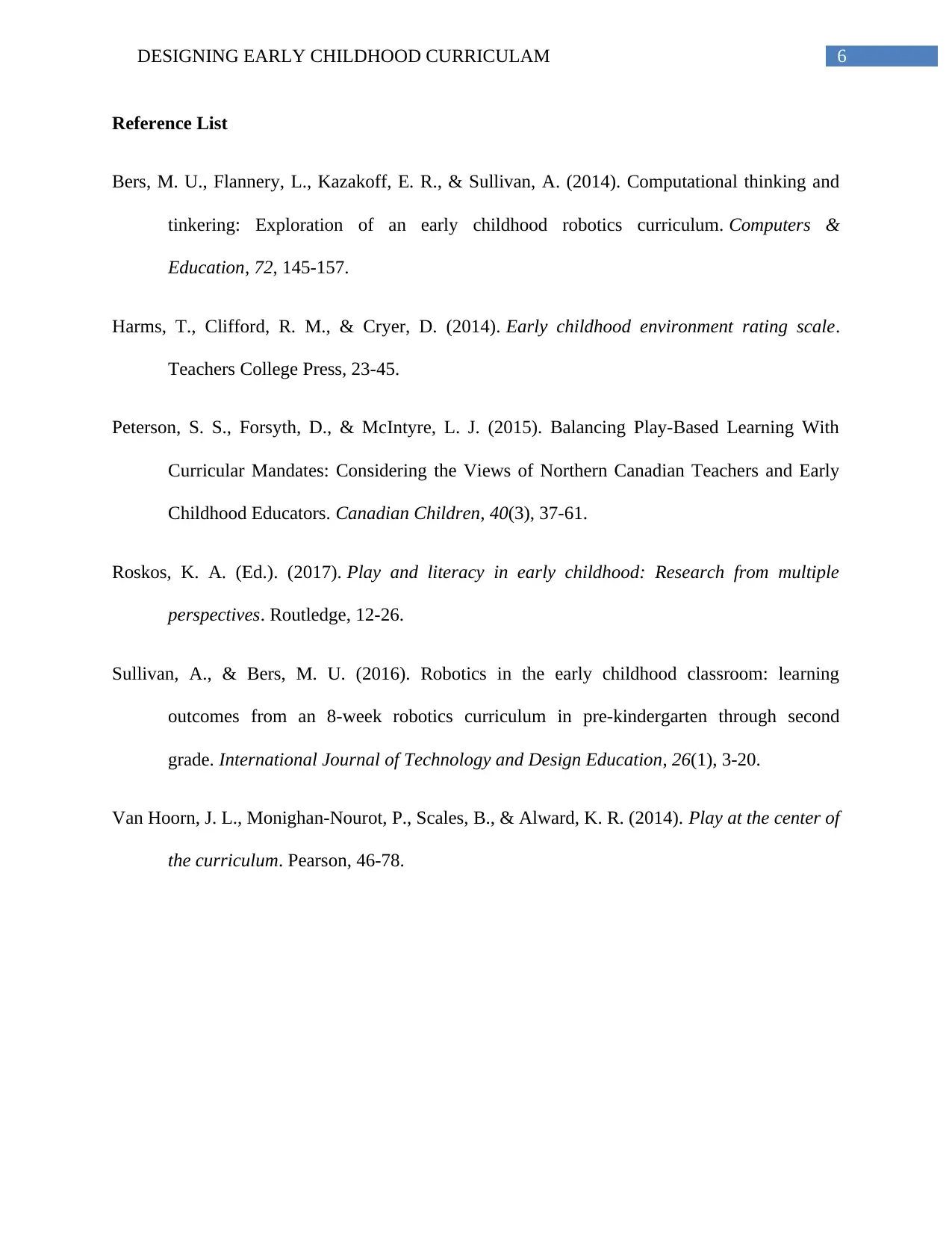
6DESIGNING EARLY CHILDHOOD CURRICULAM
Reference List
Bers, M. U., Flannery, L., Kazakoff, E. R., & Sullivan, A. (2014). Computational thinking and
tinkering: Exploration of an early childhood robotics curriculum. Computers &
Education, 72, 145-157.
Harms, T., Clifford, R. M., & Cryer, D. (2014). Early childhood environment rating scale.
Teachers College Press, 23-45.
Peterson, S. S., Forsyth, D., & McIntyre, L. J. (2015). Balancing Play-Based Learning With
Curricular Mandates: Considering the Views of Northern Canadian Teachers and Early
Childhood Educators. Canadian Children, 40(3), 37-61.
Roskos, K. A. (Ed.). (2017). Play and literacy in early childhood: Research from multiple
perspectives. Routledge, 12-26.
Sullivan, A., & Bers, M. U. (2016). Robotics in the early childhood classroom: learning
outcomes from an 8-week robotics curriculum in pre-kindergarten through second
grade. International Journal of Technology and Design Education, 26(1), 3-20.
Van Hoorn, J. L., Monighan-Nourot, P., Scales, B., & Alward, K. R. (2014). Play at the center of
the curriculum. Pearson, 46-78.
Reference List
Bers, M. U., Flannery, L., Kazakoff, E. R., & Sullivan, A. (2014). Computational thinking and
tinkering: Exploration of an early childhood robotics curriculum. Computers &
Education, 72, 145-157.
Harms, T., Clifford, R. M., & Cryer, D. (2014). Early childhood environment rating scale.
Teachers College Press, 23-45.
Peterson, S. S., Forsyth, D., & McIntyre, L. J. (2015). Balancing Play-Based Learning With
Curricular Mandates: Considering the Views of Northern Canadian Teachers and Early
Childhood Educators. Canadian Children, 40(3), 37-61.
Roskos, K. A. (Ed.). (2017). Play and literacy in early childhood: Research from multiple
perspectives. Routledge, 12-26.
Sullivan, A., & Bers, M. U. (2016). Robotics in the early childhood classroom: learning
outcomes from an 8-week robotics curriculum in pre-kindergarten through second
grade. International Journal of Technology and Design Education, 26(1), 3-20.
Van Hoorn, J. L., Monighan-Nourot, P., Scales, B., & Alward, K. R. (2014). Play at the center of
the curriculum. Pearson, 46-78.
1 out of 7
Related Documents
Your All-in-One AI-Powered Toolkit for Academic Success.
+13062052269
info@desklib.com
Available 24*7 on WhatsApp / Email
![[object Object]](/_next/static/media/star-bottom.7253800d.svg)
Unlock your academic potential
Copyright © 2020–2025 A2Z Services. All Rights Reserved. Developed and managed by ZUCOL.




